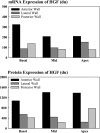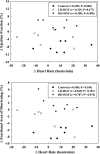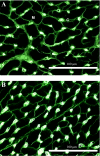Myocardial transfection with naked DNA plasmid encoding hepatocyte growth factor prevents the progression of heart failure in dogs
- PMID: 21217070
- PMCID: PMC3075044
- DOI: 10.1152/ajpheart.00636.2010
Myocardial transfection with naked DNA plasmid encoding hepatocyte growth factor prevents the progression of heart failure in dogs
Abstract
This study examined the effects of localized intramyocardial injections of hepatocyte growth factor (HGF) naked DNA plasmid on the progression of left ventricular (LV) dysfunction and remodeling in dogs with moderate heart failure (HF). Twenty-one dogs with intracoronary microembolization-induced HF [LV ejection fraction (EF) = 35-40%] were randomized into three treatment groups, namely, high-dose HGF plasmid (4.0 mg, n = 7), low-dose HGF plasmid (0.4 mg, n = 7), and sham-operated controls treated with normal saline (n = 7). A total of 10-15 injections of HGF plasmid or saline were made directly into the anterior wall of LV. LV EF and end-systolic volume (ESV) were measured before randomization (pretreatment) and at the end of 3 mo of follow-up (posttreatment). Treatment effect (Δ) was calculated as the change from pre- to posttreatment. Protein expression of sarcoplasmic reticulum (SR) Ca(2+)-cycling proteins was determined in LV tissue obtained from the sites of HGF injection and remote areas. Low-dose HGF attenuated the decline in EF (ΔEF: -3 ± 1 vs. -8 ± 1%, P < 0.05) and the increase in ESV (ΔESV: 6 ± 2 vs. 10 ± 1 ml, P < 0.05) seen in control sham-operated dogs, whereas high-dose HGF significantly increased EF (ΔEF: 4 ± 1 vs. -8 ± 1%, P < 0.05) and prevented the increase in ΔESV (ESV: -1 ± 1 vs. 10 ± 1 ml, P < 0.05) compared with control dogs. Treatment with high- and low-dose HGF improved the expression of the SR Ca(2+)-cycling proteins compared with controls. In conclusion, regional intramyocardial injections of HGF naked DNA plasmid improve regional and global LV function and prevent progressive LV remodeling.
Figures




Similar articles
-
Chronic monotherapy with rosuvastatin prevents progressive left ventricular dysfunction and remodeling in dogs with heart failure.J Am Coll Cardiol. 2007 Aug 7;50(6):551-7. doi: 10.1016/j.jacc.2007.04.050. Epub 2007 Jul 23. J Am Coll Cardiol. 2007. PMID: 17678740
-
Therapy with cardiac contractility modulation electrical signals improves left ventricular function and remodeling in dogs with chronic heart failure.J Am Coll Cardiol. 2007 May 29;49(21):2120-8. doi: 10.1016/j.jacc.2006.10.082. Epub 2007 May 17. J Am Coll Cardiol. 2007. PMID: 17531662
-
Ranolazine combined with enalapril or metoprolol prevents progressive LV dysfunction and remodeling in dogs with moderate heart failure.Am J Physiol Heart Circ Physiol. 2008 Nov;295(5):H2149-55. doi: 10.1152/ajpheart.00728.2008. Epub 2008 Sep 26. Am J Physiol Heart Circ Physiol. 2008. PMID: 18820026 Free PMC article.
-
Improvement of cardiac sarcoplasmic reticulum calcium cycling in dogs with heart failure following long-term therapy with the Acorn Cardiac Support Device.Heart Fail Rev. 2005 Jun;10(2):149-55. doi: 10.1007/s10741-005-4642-0. Heart Fail Rev. 2005. PMID: 16258722 Review.
-
Effects of cardiac support device on reverse remodeling: molecular, biochemical, and structural mechanisms.J Card Fail. 2004 Dec;10(6 Suppl):S207-14. doi: 10.1016/j.cardfail.2004.09.009. J Card Fail. 2004. PMID: 15803552 Review.
Cited by
-
Degradable acetalated dextran microparticles for tunable release of an engineered hepatocyte growth factor fragment.ACS Biomater Sci Eng. 2016 Feb 8;2(2):197-204. doi: 10.1021/acsbiomaterials.5b00335. Epub 2015 Dec 14. ACS Biomater Sci Eng. 2016. PMID: 29333489 Free PMC article.
-
Cardiovascular gene therapy for myocardial infarction.Expert Opin Biol Ther. 2014 Feb;14(2):183-95. doi: 10.1517/14712598.2014.866085. Epub 2013 Dec 16. Expert Opin Biol Ther. 2014. PMID: 24328708 Free PMC article. Review.
-
Effects of acute intravenous infusion of apelin on left ventricular function in dogs with advanced heart failure.J Card Fail. 2013 Jul;19(7):509-16. doi: 10.1016/j.cardfail.2013.05.004. J Card Fail. 2013. PMID: 23834927 Free PMC article.
-
In vivo site-specific transfection of naked plasmid DNA and siRNAs in mice by using a tissue suction device.PLoS One. 2012;7(7):e41319. doi: 10.1371/journal.pone.0041319. Epub 2012 Jul 23. PLoS One. 2012. PMID: 22844458 Free PMC article.
-
Change in hepatocyte growth factor concentration promote mesenchymal stem cell-mediated osteogenic regeneration.J Cell Mol Med. 2012 Jun;16(6):1260-73. doi: 10.1111/j.1582-4934.2011.01407.x. J Cell Mol Med. 2012. PMID: 21831134 Free PMC article.
References
-
- Ahmet I, Sawa Y, Iwata K, Matsuda H. Gene transfection of hepatocyte growth factor attenuates cardiac remodeling in the canine heart: a novel gene therapy for cardiomyopathy. J Thorac Cardiovasc Surg 124: 957– 963, 2002 - PubMed
-
- American Physiological Society Guiding principles for research involving animals and human beings. Am J Physiol Regul Integr Comp Physiol 283: R281– R283, 2002 - PubMed
-
- Azuma J, Taniyama Y, Takeya Y, Iekushi K, Aoki M, Dosaka N, Matsumoto K, Nakamura T, Ogihara T, Morishita R. Angiogenic and antifibrotic actions of hepatocyte growth factor improve cardiac dysfunction in porcine ischemic cardiomyopathy. Gene Ther 13: 1206– 1213, 2006 - PubMed
-
- Bottaro DP, Rubin JS, Faletto DL, Chan AM, Kmiecik TE, Vande Woude GF, Aaronson SA. Identification of the hepatocyte growth factor receptor as the c-met proto-oncogene product. Science 251: 802– 804, 1991 - PubMed
-
- Chen K, Mehta JL, Li D, Joseph L, Joseph J. Transforming growth factor beta receptor endoglin is expressed in cardiac fibroblasts and modulates profibrogenic actions of angiotensin II. Circ Res 95: 1167– 1173, 2004 - PubMed
Publication types
MeSH terms
Substances
Grants and funding
LinkOut - more resources
Full Text Sources
Other Literature Sources
Medical
Research Materials
Miscellaneous

